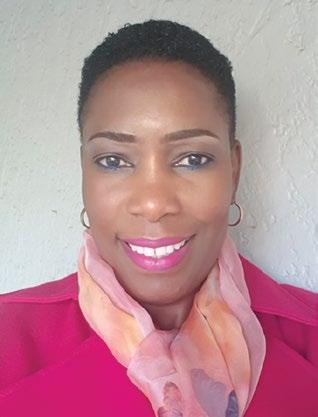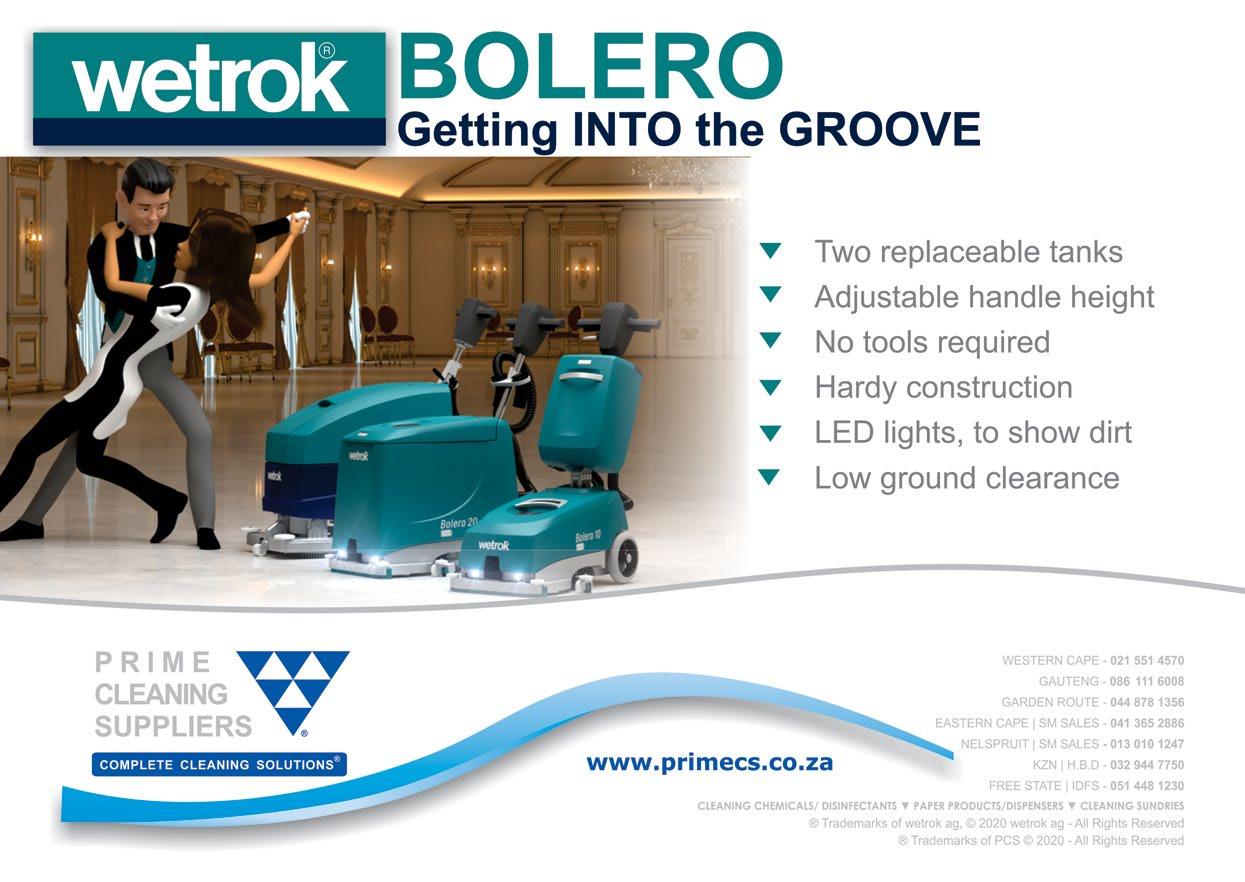
15 minute read
Features
Important labour trends in commercial cleaning
International reports indicate tremendous opportunity in the commercial cleaning industry – some projections
Advertisement
peg it at $175 billion in annual US revenues. As a result, commercial cleaning firms are investing in employees
in a big way to improve retention and quality of service.
There are, however, enormous challenges, too. Cleaning companies lose, on average, 55 percent of their business base each and every year, largely due to low customer satisfaction. While some of that may be due to pricing or inadequate relationship management, employee-driven factors – poor performance and low quality of cleaning – are key drivers of customer defections.
One important factor is the annual high rate of employee turnover, ranging anywhere from 200 percent to as much as 400 percent. This deprives customers of the familiar faces, employee experience, and consistency they value, and costs employers an average of US$3 300 per employee replacement. Here are four employee-related cleaning-services trends that any firm can profit from, according to Tork USA’s better business portal.
Trend #1: Training turns commercial cleaning employees from workers into competitive assets There is a persistent but inaccurate impression that because cleaning requires no special education, new employees can be expected to simply show up and do satisfactory work. In fact, the lack of training in cleaning companies produces dissatisfaction for customers and employees alike.
Poorly trained workers are slower, less thorough and more likely to make errors or have accidents. They experience less job satisfaction, more stress, and are more likely to leave sooner than their better-trained and equipped counterparts. (Note: The quality of cleaning products and equipment is also key to the quality of an employee’s work and the ease with which they can do it.) Managers require training, too – on how to train, motivate and monitor employees. Every reduction in errors or improvement in accuracy improves efficiency, customer retention and, ultimately, profitability. Also, when you have a reliably efficient, consistent, cleaning crew, you can more confidently create highly competitive bids, bringing in more business.
The increased recognition of the business-building value of effective training has led to a wealth of training options, from pre-packaged courses for employee onboarding, to specialised ‘green cleaning’ instruction, to continuing education offerings for managers.
Trend #2: Employee incentives perk up retention rates in cleaning services Education gets you started down the right path, but it takes motivation to keep your employees going, especially in an era when it’s relatively easy to switch jobs. Pay is, as ever, the biggest source of employee motivation, but hardly the only one. Cleaning contractors should be offering employee benefits that range from practical life enhancements to on-the-job morale boosting. Paid time off, health insurance, individual employee recognition awards and even oldfashioned company team-building exercises are all on the ‘employee perks’ menu now.
Trend #3: New IoT technology gives cleaning teams ‘superpowers’ The terms ‘cleaning’ or ‘janitorial services’ may not instantly suggest innovative technology, but these days it really should. Phone-based apps allow a manager to monitor use levels, equipment locations and employee progress in large facilities. Smart washrooms feature paper dispensers that notify you when supplies run low. Floor-cleaning robots relieve employees of mundane, timeconsuming labour, freeing them up for higher-value tasks. Today’s ultraconnected technology is transforming the way commercial cleaning services work, with the potential to make employees much more efficient and effective.

Trend #4: A ‘healthy, green clean’ appeals to both employees and customers Multiple surveys show that customers prefer to do business with companies that care about sustainability – and employees, especially the up-andcoming generations, prefer to work for them, too.
That’s why green cleaning programmes are taking off, as companies employ eco-friendly products and methods and examine their supply chains and partner networks for like-minded organisations. As mentioned briefly above, there are even training programmes dedicated to green cleaning. These help workers learn why and how to use this relatively new category of cleaning supplies and processes, with an eye toward improving healthiness alongside cleanliness.
What will be the next big employee trend in the commercial cleaning industry?
Cleaning companies will have to continue investing in employees. Expect to see big advances – and continuing change – in all four areas listed above.
Sources Qlicket.com: What is the total cost of replacing a typical hourly employee? | 4-M.com: How Janitorial Turnover Impacts your Business | Green Clean Institute: Janitorial new hire orientation | ISSA: Cleaning Management Institute | Clean Link: What BSCs must do to solve retention woes | Clean Link: The importance of employee recognition | Clean Link: Providing perks to retain employees | Clean Link: Statistics on the commercial cleaning industry | Wilburn Company: Top 3 commercial cleaning trends in 2019 | Clean Link: Improve janitorial bids by focusing on efficiency | ISSA: IoT restrooms are smart business.
Cleaning services industry presents opportunities for unemployed youth
With the matriculant class of 2019 having wrapped up their high school years, some will proceed to higher
education institutions, while others will not be able to do so.
There are matriculants from as far back as five years who are still sitting at home; they could not proceed into higher-learning institutions for a number of reasons – social and economic. The country’s unemployment rate continues to increase, with unemployment currently at 29.1 percent and the burden of unemployment mostly concentrated among the youth aged 15–34 years, accounting for 63.4 percent of the total number of unemployed persons according to Statistics South Africa.
“There is a need to explore opportunities in which to absorb these young people into the work environment. The cleaning industry is one of the country’s highest employers – and presents opportunities of entry into the workplace for young people,” says Cathy Viriri, National Operations Director, Cleaning Division at Servest Facilities Management.
“Greater efforts must be made to get young people more involved in this
African Cleaning Review January/February 2020 space, because all they need is a stepping stone – thereafter they can work towards upskilling to get into their ideal jobs,” says Viriri.
The local contract cleaning industry has over 1 500 contract cleaning companies across South Africa, employing more than 100 000 people. “One of the biggest challenges that the country faces is that young people perceive cleaning as a lowlevel job and ‘uncool’, but what they need to be looking at is the prospect of what they could become within these roles, instead of where they start. If we can achieve that mindset shift, more could be done to bring down the high unemployment rate among young people,” says Viriri. She explains that the minimum entry requirement to become a cleaner is a matric certificate – thereafter most reputable companies provide on-the-job training in line with industry practices to enable entrants to perform their duties and understand the standard operating procedures; they receive various forms of site-specific training where applicable, as well as health and safety training.
“The average age of a cleaning colleague at Servest is around 38 years, and we need to get more young people into these roles and create an understanding of the diverse opportunities available in the sector,” says Viriri.
She notes that the cleaning industry is a developing industry expected to impact the country’s economy, as cleaning functions provide a wide range of activities that include both automation and human support. “There are opportunities for growth as well in this space, including specialisation, especially in specialised industry sectors where cleaners can upskill to become a specialist cleaner like in mining, healthcare, and manufacturing. While working, they can explore growth, continuous learning and upskilling opportunities.
“There are also opportunities for onthe-job training and exposure to other business functions such as finance and administration, supervisory roles, quality control, and so on. We need to move beyond the perceptions around jobs such as cleaning, security services – the sort of jobs that young people perceive as low-level jobs – and create awareness and highlight the opportunities that exist within these jobs.”
Speaking about innovations and technology taking over some of the more laborious jobs in the future, Viriri says: “As the 4th Industrial Revolution [4IR] unfolds, we are seeing tremendous technological advancements to perform laborious roles faster and more effectively. However, South Africa remains very labour intensive, and while these innovations are coming, the idea is to get young people involved and upskill them to prepare them for future tech functions. Some of these machines will not require that someone has a technical degree, for example, to
operate that machine, but require that they are trained on the full functions of the machine in order to operate it effectively. We have some young people sitting at home jobless, with their matric qualifications, and we need to get them integrated into the 4IR workspace of the future through relevant training straight from high school.”
She continues: “As deep concerns remain for the high unemployment among youth, employers must work together with the government to resolve some of the challenges that the country continues to grapple with. They must continue to drive training and developing young people for the work environment and establish opportunities for informal and formal training around the use of technology,” concludes Viriri.
Servest is a leading black-owned facilities management company, providing integrated facilities solutions for the internal and external, built and marine, environments, including
Cathy Viriri

solutions such as internal and external design and space planning, cost optimisation analysis, carbon-impact reduction, cleaning, parking, catering, hygiene, security, pest control, office plants, and landscaping solutions across multiple African countries. The group employs 24 000 people across 11 110 sites.
For more information visit: www.servest.co.za

How cleaning businesses can leverage technology
By Gregory Venter
That technology and data are changing the way industries conduct their
day-to-day business is not a point of contention. Retailers, hospitals,
schools and hotels are using data to make their facilities more user
friendly, cleaner and profitable.

Gregory Venter
In the retail sector, the ability to determine where shoppers spend the majority of time while in a store, not only helps in planning the ideal layout, but also offers clues into effective merchandising and cleaning needs. Examples of data analysis improving efficiency and cleanliness are hospitals that rely on heat-map analytics to address staffing needs; and some schools are incorporating ATP swabs and a bioluminescence reader to identify the dirtiest sections of a classroom. This information then points cleaning staff to areas that need special attention.
Data and technology will play big roles in the future of almost every industry, including the cleaning industry. It is important to stay current by adopting technology now that leads to industry best practices for data collection and analysis, to utilise for improvements moving forward.
For example, the Tennant’s IRIS Asset Manager offers a solution that can help customers improve their efficiencies and productivity with intelligent insights to drive their cleaning performance. IRIS provides complete visibility of a client’s fleet, delivering key performance metrics and intelligent insights that enable clients to increase productivity, reduce cleaning costs, ensure cleaning consistency and make
African Cleaning Review January/February 2020 informed decisions, thereby driving cleaning operations forward.
Recent IRIS enhancements also deliver comprehensive Tennant maintenance-spend data and detailed battery-charging metrics to help customers reduce

equipment costs, increase uptime and extend battery life. IRIS Asset Manager allows customers to identify opportunities – and see where operators are not fully utilising their Tennant equipment – for example, on sites where operators clean manually.
The technology also allows for optimisation of performance by enabling cleaning-equipment fleet managers to identify underperforming sites in order to provide additional training and best practices. With the information obtained from IRIS, clients can also identify underutilised cleaning machines and redeploy these to optimise productivity. With this technology, customers are also able to keep an eye on the costs all the time. The technology allows
clients to track service information with Service Reporter to identify
misuse, abuse and user error, and resolve the issue by providing additional training to extend
equipment life where necessary. With theft in mind, clients can also minimise lost assets as Service Reporter allows the
client to receive and act upon alerts when the machine’s location changes.
Technology and data, in the short term, are all
about awareness. Lots of
companies in the cleaning industry know that the power of technology and data will enable them to work better, faster and longer, but right now, it’s a question of how this will happen and when there will be an impact. In the long term, it is all about transforming the industry. We know there are massive gains already from harnessing the power of data and that over the next generation the industry will see radical change.
Gregory Venter is the MD of Goscor Cleaning Equipment, a Bud Group company representing leading cleaning-equipment brands, including: Tennant, Elgin, Maer, Delfin, Kaivac and HighPoint. For more information visit: www.goscorcleaning.co.za

Productive contract cleaning
Gordon McVean

The marketplace offers an array of machinery to support cleaning teams, so it’s important to assess your exact needs before making your investment, says Gordon McVean, executive director of Truvox International. Whether in-house or contracted, properly equipped cleaning teams can turn in a consistently high, and competitive, performance.
This article offers greater insight into typical cleaning equipment and examples of use on hard as well as carpeted floor surfaces.
According to contract cleaners and facilities managers, one of their main priorities is to streamline their cleaning operations, demonstrating value for money and efficiency, while producing outstanding levels of cleaning. While all buyers want a well-built machine that will give many years of reliable service, contract cleaning teams, in particular, are looking for robust machines that will stand up to intensive, everyday use.
Shining example of high-speed productivity Cleaning teams under pressure to clean and maintain more hard flooring for less have a reliable ally in the Orbis eco range of rotaries. This range has been specifically designed to fully accommodate cleaning contractors’ needs. All Orbis eco models come preassembled with handle and base and are inclusive of a drive board, so teams can get straight to work.
These rotaries offer exceptional handling and productivity for cleaning and polishing hard floors, with an optional solution tank for wet scrubbing. Making light work of virtually every floor type, the Orbis eco range is ideal for retail, education and healthcare facilities. With a cleaning width of 43 cm, this economical range is available in 200 revolutions per minute (rpm), 400 rpm and Duo dual speed, suitable for both light cleaning duties and more intensive maintenance. The Orbis eco Duo provides complete floor renovation and maintenance in just one machine with two speed settings: 190 rpm and 380 rpm.
Other features to watch for, apart from build quality, are low vibration and noise levels. Operators appreciate adjustable handle heights and ergonomic design, making machines comfortable to use, even on long shifts. High pad/ brush pressure enables effective and productive cleaning and polishing, whilst a folding handle and large rear wheels make transportation of the machine easier.
High-speed rotaries may be specialised tools, but they can polish a wide variety of floor types with the right brushes or pads, such as: stone, granite, marble, terrazzo, vinyl and PVC, as well as concrete, terracotta, quarry tiles, safety floors and raised rubber.
Innovation in vacuuming Regular vacuuming is essential to keep carpets looking fresh and bright. Technical advances are setting the latest generation of vacuums apart from their old and familiar predecessors in terms of efficiency, manoeuvrability and sustainability.
Light and highly manoeuvrable machines are a popular option, as this makes transporting the machine between cleaning jobs or to different parts of a building easy. Weighing just 6 kg, our compact tub vacuum, the VTVe has an ‘A’ energy rating and comes with a 32 mm-diameter toolset – so it is compatible with standard consumables. Its dusting brush and crevice tools enable improved cleaning in hard-to-reach areas. These are stored conveniently at the back of the machine, while a wand holder facilitates tidy storage. Similar attention to detail has been paid in the design of the vacuum’s carry handle. It’s moulded to accommodate the VTVe’s wand, which sits on the handle, so the machine can easily be carried in one hand.
A cable wrap at the top of the machine, with the added protection of a hinged cover that clips in place, prevents tangling and keeps the cable out of harm’s way. Replacement of a worn or damaged cord is straightforward, thanks to the VTVe’s easy-change cord system. The process – which is tool-less – is designed to remove the need for any service technician call-out charge.
The machine is powered by an 800 W motor and has an 11.5 litre capacity for high productivity of some 230 square metres per hour.
Any advanced vacuum should also safeguard indoor air quality to help control allergies. This is crucial where hygiene is a priority, but we also believe it’s important in every business sector. We have committed to the HEPA 13 standard of filtration. It means that these vacuums trap particles of 0.3 microns and larger, or some 99.97 percent of airborne matter. As on our battery upright, the bag also has an automaticclosing feature to prevent dust particles from escaping while it’s being replaced.
Rising to the challenge Every building and sector has its challenges, all of which are surmountable with the correct equipment. Cleaning teams should assemble the right mix and balance of mechanical cleaning capabilities so the operation is efficient and cost effective. This will be determined by a range of factors including the scale of the facility, different floor types, area of each, the size of the cleaning team and budget – which should reflect those factors and the standards of cleanliness specified by management. Whether in-house or contracted, properly equipped cleaning teams can turn in a consistently high, and competitive, performance.











